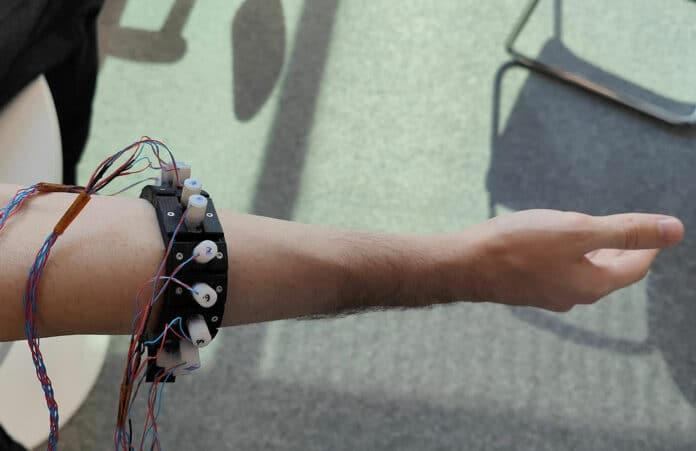For people who have lost a hand, having a functional prosthetic hand is crucial for everyday activities.
To improve the control of prosthetic hands down to individual fingers, researchers at Fraunhofer are developing a new system that reportedly allows for more accurate and sensitive execution of commands. They are using ultrasonic sensors instead of conventional electrodes to detect nerve impulses in muscle tissue in the arm and convert them into hand movements.
The technology is being developed as a part of an EU SOMA project, which involves seven research groups from five countries.
The current version of the system is a bracelet that can be worn on the forearm. Unlike traditional methods that use electrodes, the new system utilizes an array of ultrasonic sensors that continuously emit dozens of ultrasound pulses every second into the underlying muscle tissue in the forearm.
Unlike electrical impulses, sound waves are reflected by tissue. The time it takes for the reflected signals to travel provides insight into the physical depth of the muscle strand that is reflecting the respective sound wave. This provides an opportunity to study muscle tissue contractions in detail, which are triggered by nerve stimuli from the brain.
By identifying typical activation patterns in the muscle, such as those that represent specific hand or finger movements, researchers can better understand how muscles work.
The project aims to use AI-controlled software in a compact electronic box that can be worn on the patient’s body to take over the job of identification. The decoded signals can then be sent as a command to the actuators in the prosthetic hand, triggering the movement of the prosthetic fingers. All control commands are detected, analyzed, and transmitted in real time.
“The ultrasonic-based control acts with greater sensitivity and accuracy than would be possible with electrodes. The sensors are able to detect varying degrees of freedom such as flexing, extending, or rotating,” says Dr. Marc Fournelle, head of the Sensors & Actuators group at Fraunhofer IBMT, who is responsible for developing SOMA ultrasonic sensors within the project.
In the next stage, researchers want to improve the temporal resolution of the sensors further and make the electronics smaller so that the prosthesis can be controlled even more accurately and comfortably. The sensor bracelet will ultimately be replaced with a miniaturized transducer array built into the cuff of the prosthesis itself. Thinking of improved suitability for everyday use, it is also conceivable that AI and control software may be integrated into a smartphone someday.
Researchers also want to make the design bidirectional, with the brain also receiving sensory stimuli from the prosthesis. The prosthetic hand should not only be able to execute commands but also return feedback that the person wearing the prosthesis can feel as a sensory stimulus and react to. Those signals will be delivered via electrodes implanted in or onto nerves.
From there, they transmit signals sent by the prosthesis to the brain as a sensory stimulus in the form of specific nerve stimulation. This means the person’s brain is getting feedback from the artificial hand and can send back commands.
